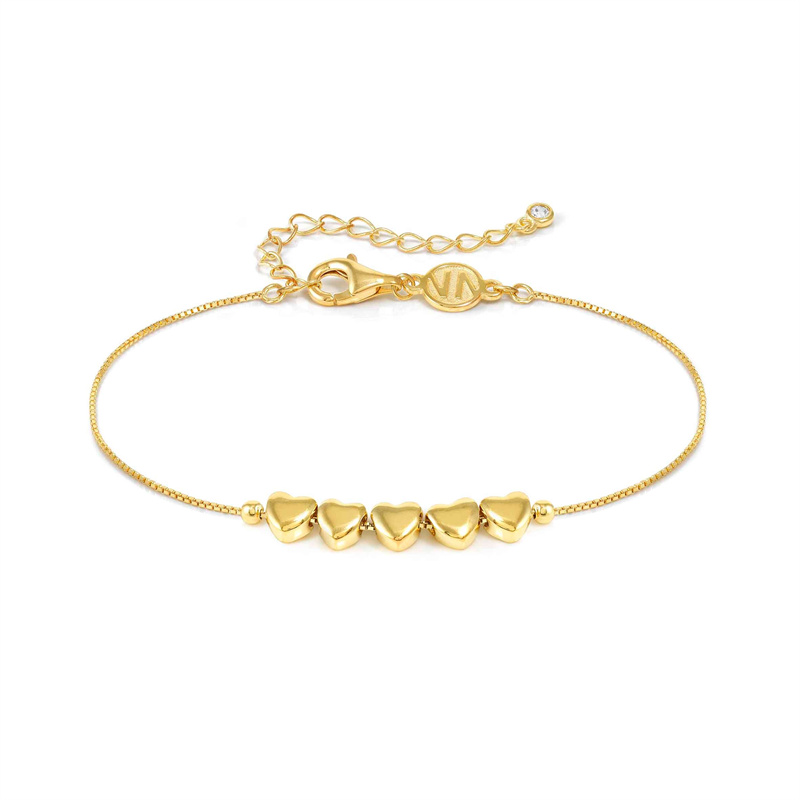How to Make Custom Gold-Plated Silver Bracelets More Resistant to Oxidation: A Comprehensive Guide
Introduction
Gold-plated silver bracelets are a popular choice for jewelry lovers due to their luxurious appearance, affordability, and versatility. However, one of the biggest challenges with gold-plated jewelry is oxidation and tarnishing, which can diminish its shine and beauty over time.

For jewelry manufacturers, retailers, and customers, ensuring that custom gold-plated silver bracelets remain tarnish-free is crucial for maintaining product quality and customer satisfaction. This 5,000-word guide explores the best practices to prevent oxidation in gold-plated silver bracelets, covering:
-
Why Gold-Plated Silver Bracelets Tarnish
-
Material Selection: Choosing the Right Base Metal & Plating
-
Advanced Plating Techniques to Prevent Oxidation
-
Protective Coatings & Sealants
-
Proper Storage & Handling During Production
-
Post-Production Care & Maintenance Tips
-
Quality Control & Testing Methods
-
Sustainable & Long-Lasting Solutions
By following these expert recommendations, jewelry makers and buyers can significantly extend the lifespan of their gold-plated silver bracelets while keeping them looking radiant.
1. Why Gold-Plated Silver Bracelets Tarnish
1.1 The Science Behind Oxidation & Tarnishing
-
Silver Oxidation: When silver (Ag) reacts with sulfur (H₂S) in the air, it forms silver sulfide (Ag₂S), leading to black tarnish.
-
Gold Plating Wear-Off: Over time, the thin gold layer erodes, exposing the silver underneath to oxidation.
1.2 Factors That Accelerate Tarnishing
✔ Exposure to Moisture & Humidity (sweat, water, humid climates)
✔ Contact with Chemicals (perfume, lotion, chlorine, cleaning agents)
✔ Friction & Abrasion (rubbing against skin, clothing, or other jewelry)
✔ Air Pollution & Sulfur Exposure (common in urban areas)
2. Material Selection: Choosing the Right Base Metal & Plating
2.1 High-Quality Sterling Silver (925 Silver) as the Base
-
Why 925 Silver?
-
Contains 7.5% copper for durability.
-
Less prone to rapid tarnishing compared to pure silver.
-
-
Nickel-Free & Hypoallergenic Options – Reduces skin irritation.
2.2 Optimal Gold Plating Thickness
-
Standard Gold Plating (0.5-1 micron) – Wears off quickly.
-
Heavy Gold Plating (2-3 microns) – Lasts longer before exposing silver.
-
18K vs. 24K Gold Plating – 18K is more durable due to alloy hardness.
2.3 Alternative Base Metals for Extra Protection
-
Brass or Copper Underlay – Cheaper but requires thicker plating.
-
Rhodium Undercoating – Adds a protective barrier between silver and gold.
3. Advanced Plating Techniques to Prevent Oxidation
3.1 Multi-Layer Plating Process
-
Nickel or Rhodium Undercoat – Prevents silver from reacting.
-
Thick Gold Plating (2-3 microns) – Slows down wear.
-
Protective Top Coat (Optional) – Clear lacquer or anti-tarnish sealant.
3.2 PVD (Physical Vapor Deposition) Coating
-
More Durable Than Electroplating – Resists scratches & fading.
-
Used in Luxury Jewelry – Longer-lasting shine.
3.3 Pulse Plating vs. Traditional Plating
-
Pulse Plating – Creates a denser, more even gold layer.
-
Traditional DC Plating – Cheaper but less uniform.
4. Protective Coatings & Sealants
4.1 Clear Lacquer Coating
-
Pros:
-
Creates a waterproof barrier.
-
Inexpensive & easy to apply.
-
-
Cons:
-
Can wear off over time.
-
May cause allergies if low-quality.
-
4.2 Anti-Tarnish Solutions
-
Jewelry Shield Sprays – Temporary protection.
-
Silicon-Based Sealants – Longer-lasting than lacquer.
4.3 Wax or Oil Coating (For Storage)
-
Beeswax or Jewelry Wax – Protects during shipping/storage.
5. Proper Storage & Handling During Production
5.1 Preventing Tarnish Before Sale
-
Anti-Tarnish Paper or Strips – Absorbs sulfur in packaging.
-
Airtight Polybags – Reduces air exposure.
5.2 Humidity-Controlled Storage
-
Silica Gel Packs – Keeps moisture away.
-
Dehumidifiers in Storage Rooms – Ideal for tropical climates.
6. Post-Production Care & Maintenance Tips
6.1 Cleaning Gold-Plated Silver Bracelets
-
Do’s:
-
Use a soft microfiber cloth.
-
Clean with mild soap + lukewarm water.
-
-
Don’ts:
-
Avoid baking soda, toothpaste, or harsh chemicals.
-
Never scrub aggressively.
-
6.2 Wear & Care Instructions for Customers
✔ Remove before swimming/showering.
✔ Avoid contact with perfume & lotions.
✔ Store in a dry, airtight jewelry box.
7. Quality Control & Testing Methods
7.1 Salt Spray Test (ASTM B117)
-
Simulates long-term exposure to humidity.
-
Checks plating durability.
7.2 Rub Test (ISO 3160-2)
-
Measures resistance to friction.
7.3 XRF Testing for Plating Thickness
-
Ensures gold layer meets specifications.
8. Sustainable & Long-Lasting Solutions
8.1 Recycled Silver & Eco-Friendly Plating
-
Cyanide-Free Gold Plating – Safer for workers & environment.
8.2 Educating Customers on Longevity
-
Include care cards with purchases.
-
Offer replating services.
Conclusion: Key Takeaways for Oxidation-Resistant Gold-Plated Bracelets
By implementing:
✅ High-quality 925 silver + thick gold plating
✅ Protective undercoating (rhodium/nickel)
✅ Anti-tarnish packaging & storage
✅ Proper cleaning & maintenance guidelines
Jewelry makers can drastically reduce oxidation and ensure their custom gold-plated silver bracelets stay beautiful for years.
